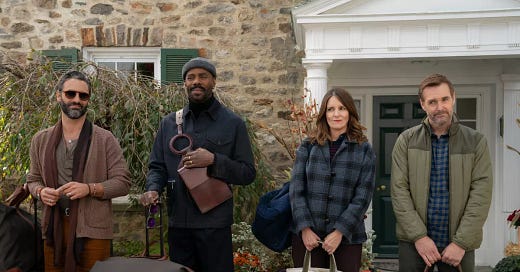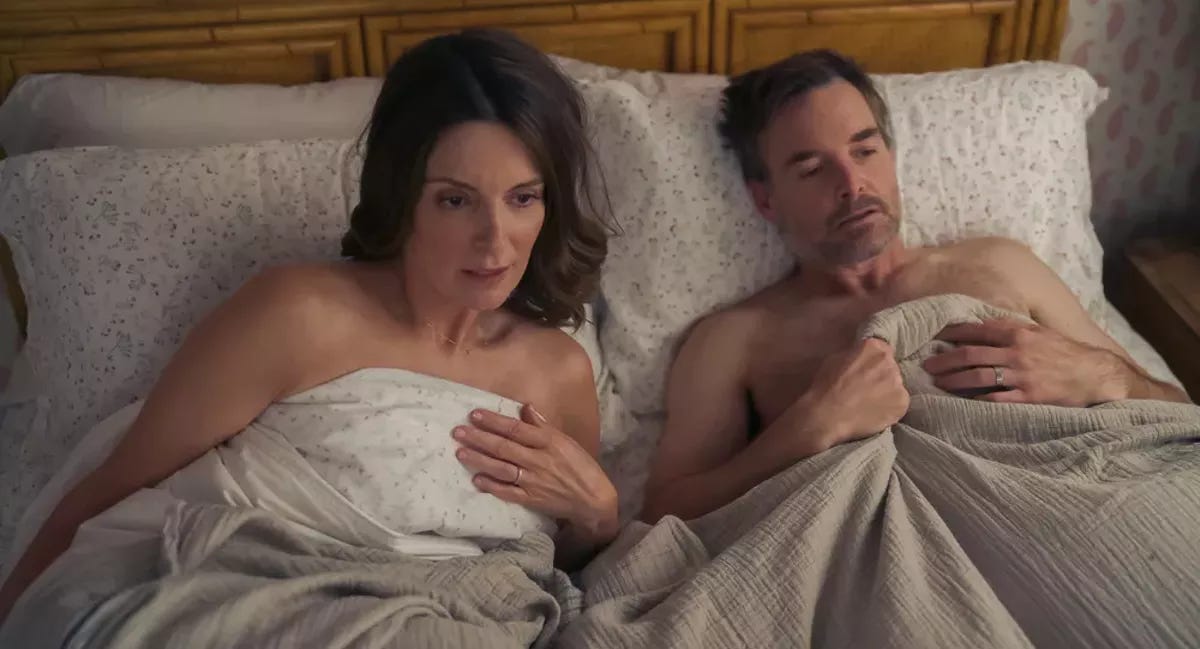The 'Four Seasons' version of a midlife crisis seems great, actually
If you're going to experience middle-aged Relationship Problems anyway, it might as well happen at a nice Airbnb.
To everything, there is a season: a time to be born, a time to get old before you’re ready, a time to blow your life up in order to feel things again, a time to badly injure yourself while trying to impress a much younger woman. Turn, turn, turn.
The new Netflix series The Four Seasons is a midlife-crisis dramedy about affluent people and their relationship issues. In spite of this, it is worth watching because, as a Tina Fey project, the show goes down easily even as many of its jokes will hit close to home for anybody currently experiencing back pain from sleeping in the wrong position or nursing a hangover from a glass of wine three nights ago.
The Four Seasons is an adaptation of a 1981 Alan Alda movie of the same name. Created by Fey and some of her old 30 Rock collaborators, the updated Four Seasons expands the film into an eight-episode series. It follows a group of six college friends, now middle-aged, who meet once every few months for a weekend getaway.
We don’t see much of their lives between vacations, so it’s good that they can all afford to travel so much. The male couple of the group, Danny (a tremendous Colman Domingo) and Claude (Marco Calvani), mentions a separate circle of much hotter gay friends, presumably doubling their group-trip obligations and expenses. That all sounds very stressful. I love reconnecting with people, but four destination trips every year for three decades with the same crew feels like a lot. On top of that, everyone is having Relationship Problems caused by aging into their 50s with partners they met in their 20s. Marriage, in case you haven’t heard, is hard work.
Or so we learn during the early episodes (there are two per trip), an idyllic stay at a lake house owned by Nick (Steve Carrell) and Anne (Kerri Kenney-Silver) to celebrate their 25th wedding anniversary. Nick spoils the fun by telling the others he’s going to divorce Anne, who, we soon learn, is throwing a big surprise vow-renewal ceremony, which complicates his plan while supplying sad-trombone sitcom hijinks.
Here The Four Seasons executes a delicate mixture of the painfully funny and the simply painful. I wish there were more such moments, but the ones we get are saved for maximum impact; toward the end of the series, there is a Chekhovian acoustic-guitar needle-drop during a particularly sad moment that had me howling.
Alexa, how will tariffs impact the costs of awkward friend vacations?
We jump ahead to their next trip, a jaunt to a tropical yurt resort organized by — big reveal — Nick’s new girlfriend, Ginny (Erika Henningsen), a sexy blonde who is in her early 30s. This dynamic produces friction in the rest of the group, who regard her with a combination of suspicion and Gen-X snobbery.
While the ensuing Nick/Anne/Ginny triangle is the most visible source of drama, the other relationships are shaky for their own reasons. Kate (Fey) and Jack (Will Forte) are reportedly soul mates, but cracks are developing due to stasis. Danny and Claude struggle under the weight of health issues and a newly tangible awareness of mortality. Anne struggles to keep her life together without forcing her friends to choose sides, and Nick starts to realize that once the excitement of his new relationship dies down, he and Ginny are just two people navigating each other’s bullshit, this time without the benefit of at least belonging to the same generation and understanding what the other partner is talking about most of the time.
Since the friends on The Four Seasons are seemingly unburdened with financial worries, the series has the luxury of being selective about which age-specific challenges it places in front of them.
Conflicts involving intimacy, communication and emotional compatibility across an adult lifetime are no joke, but most people have to juggle them alongside anxieties about recessions, mortgages, insurance, retirement savings, aging parents, being replaced by A.I., etc. Two of the couples have daughters who both attend college at the group’s alma mater; one matters to the plot, one appears briefly and then vanishes, and neither seems to induce any stress about how their tuition at an expensive-looking private university is being paid. The series is almost acrobatic in avoiding having to acknowledge its characters’ privilege, much less interrogate it.
At least ‘The White Lotus’ KNOWS its rich-ass characters are insufferable
The Four Seasons is a good example of why the conventional midlife-crisis narrative is getting to be such a hard sell. It’s because the issues that instigate this type of plot can no longer be siloed off from the simmering economic unease and roiling political angst that have infiltrated almost every aspect of all but the most comfortable lives.
You know these stories. A protagonist, usually male, skids into his 40s or thereabouts, looks at everything in his life and wonders, Is this it? The countless famous examples in pop culture include shows such as Mad Men (fun fact: Don Draper was THIRTY-FIVE in the first season). Also, all Woody Allen movies, most of the good Philip Roth novels, the Talking Heads song “Once In a Lifetime,” every Steely Dan album, Lost In Translation, American Beauty, Old School, Sideways, Breaking Bad, Fleishman Is In Trouble, Your Friends & Neighbors, The White Lotus and so on.
But is it even a believable premise anymore? As I entered this phase of life, I nervously awaited the psychological freakout, which I’d been programmed to expect from pop culture, that would send me to the nearest Corvette dealership. But instead of wondering whether there’s more to life, I feel…happy? It’s weird to even say that out loud.
I think this is because I only recently arrived in a position that resembles conventional adult steadiness, at least in terms of home, family and work. All it took was a stable relationship, a decent house, an excellent dog and a job I didn’t hate — all of which have started to feel like rare achievements. Taking a longer-than-average time to hit those milestones made it feel like this was a part of life worth savoring instead of dreading. (Plenty of time for that later.) The asterisk to this contentment is the built-in advantage of being a white guy from a middle-class family who made it through college without a suffocating amount of debt. I may ask myself, how did I get here? And the answer is that I was born lucky and mostly stayed that way.
Obviously not everyone can say the same. The New York Times in 2023 interviewed several millennials in their early 40s about whether they were experiencing traditional midlife crises, and most said they were too busy trying to make ends meet to stare out the window and think about what might have been. According to the piece, written by Jessica Grose:
“The stressors of midlife for so many Americans are not existential; they’re material — economic, familial and political. They’re about the seemingly decent paycheck that is spent almost entirely on child care, student loan repayment and medical debt, leaving nothing to build a nest egg or save for their children’s futures.”
In order to wonder ‘Is this it?’, there has to be a THIS
Feeling trapped by the dullness of settled life means having achieved settledness, which feels less and less baked into the American experience. That white picket fence is a prison only if you can afford a place that has one, and have you looked at Zillow lately? Half a million dollars barely gets you a home that isn’t currently on fire. Median housing prices have gone up about 25 percent since 2020 (although it feels like a lot more than that). Student loan debt has increased sevenfold since the 1990s. Wages have basically been stagnant relative to the cost of living since the 1970s while the wealth gap grows ever wider. Millennials, we’re often reminded, are the first modern generation to be worse off than their parents, and surely will not be the last.
Our new century’s cascading traumas — 9/11, Iraq, the Great Recession, climate change, surveillance capitalism, COVID, Jan. 6, America’s collapse into autocracy — have further shattered the illusion of stability on which the idea of a midlife crisis is predicated. And as a result we buy homes later (if ever), get married older (if at all) and have fewer kids (if any).
The 40-year-old who’s still working two jobs to afford a one-bedroom apartment, for instance, would likely be unmoved by the bougie malaise that the characters in The Four Seasons are able to drag to upscale vacation rentals all over the world.
This is why the Ginny arc is such a satisfying counterweight to all the middle-aged navel-gazing happening elsewhere in the series. The Much Younger Girlfriend is a low-hanging stock figure, so it would have been easy to milk her and Nick’s age gap for easy punchlines about fading youth on his part and daddy issues on hers, but the best idea in the whole show was to make her a real character. By the season’s end, she emerges as a figure of sympathy and agency, less an avatar for everything wrong with today’s young people and more so a lens to examine the older generation’s failures.
She’ll reach their season of life in due course, with plenty of data on how to manage decades-long friendships and partnerships, and plenty more about how not to. And if Ginny stays connected to the group — no major spoilers, but this is left open-ended — her presence might remind everyone that regretting their life decisions meant they had options to begin with, which must have been nice.
Other recent writing:
The Studio has good ideas beneath its cringe-comedy surface [Record-Eagle.com]
The Oscar-winning Brazilian film I’m Still Here carries a grim urgency [Record-Eagle.com]





